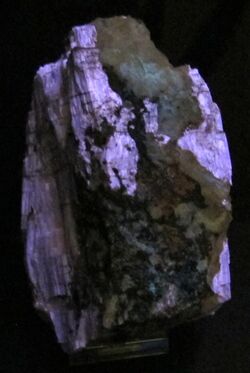Chemistry:Agrellite
| Agrellite | |
|---|---|
 Agrellite showing fluorescence in ultraviolet light | |
| General | |
| Category | Inosilicates |
| Formula (repeating unit) | NaCa2Si4O10F |
| Strunz classification | 9.DH.75 |
| Crystal system | Triclinic |
| Crystal class | Pinacoidal (1) (same H-M symbol) |
| Space group | P1 |
| Identification | |
| Color | White, grayish-white, greenish-white |
| Crystal habit | Lath - shaped like a small, thin plaster lath, rectangular in shape |
| Cleavage | perfect [110] |
| Mohs scale hardness | 5.5 |
| |re|er}} | pearly |
| Streak | white |
| Diaphaneity | translucent |
| Specific gravity | 2.88 |
| Optical properties | biaxial |
| Refractive index | nα = 1.567 nβ = 1.579 nγ = 1.581 |
| Birefringence | δ = 0.014 |
| References | [1][2] |
Agrellite (NaCa2Si4O10F) is a rare triclinic inosilicate mineral with four-periodic single chains of silica tetrahedra.
It is a white to grey translucent mineral, with a pearly luster and white streak. It has a Mohs hardness of 5.5 and a specific gravity of 2.8. Its type locality is the Kipawa Alkaline Complex, Quebec, Canada , where it occurs as tabular laths in pegmatite lenses.[4] Other localities include Murmansk Oblast, Russia, Dara-i-Pioz Glacier, Tajikistan, and Saima Complex, Liaoning, China.[4] Common associates at the type locality include zircon, eudialyte, vlasovite, miserite, mosandrite-(Ce), and calcite.[4]
Agrellite displays pink fluorescence strongly under shortwave and weakly under longwave ultraviolet light.[5][6] The fluorescent activator is dominantly Mn2+, with minor Eu2+, Sm3+, and Dy3+.[6]
It is named in honor of Stuart Olof Agrell (1913–1996), a British mineralogist at Cambridge University.
See also
References
- ↑ http://www.mindat.org/min-57.html Mindat
- ↑ http://www.webmineral.com/data/Agrellite.shtml Webmineral
- ↑ Warr, L.N. (2021). "IMA–CNMNC approved mineral symbols". Mineralogical Magazine 85 (3): 291–320. doi:10.1180/mgm.2021.43. Bibcode: 2021MinM...85..291W.
- ↑ 4.0 4.1 4.2 "Agrellite". https://www.mindat.org/min-57.html.
- ↑ "Handbook of Mineralogy". http://www.handbookofmineralogy.org/.
- ↑ 6.0 6.1 "Luminescence, fluorescence and phosphorescence of minerals". https://www.fluomin.org/uk/fiche.php?id=62.
 |

